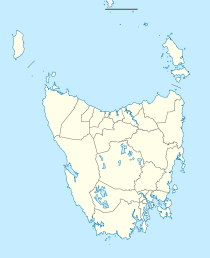Gormanston, Tasmania facts for kids
Quick facts for kids GormanstonTasmania |
|
|---|---|
| Population | 17 (2016 census) |
| LGA(s) | West Coast Council |
| State electorate(s) | Lyons |
| Federal Division(s) | Lyons |
Gormanston is a small town in Tasmania, Australia. It sits on the slopes of Mount Owen, high above the town of Queenstown. This area is known as Tasmania's West Coast. In 2016, only 17 people lived in Gormanston.
The town is located between two mountains, Mount Lyell and Mount Owen. It is "up the hill" from another old community called Linda. Linda is on the northern side of the Linda Valley.
Contents
Gormanston's Past: A Mining Town
How Gormanston Began
Gormanston was built as a "company town." This means a mining company, the Mount Lyell Mining and Railway Company, created it for its workers. The town was close to the Iron Blow copper mine. Later, it also had a train station for the North Mount Lyell Railway. However, this railway stop at Gormanston railway station did not last very long.
The town might have been named after Jenico Preston, 14th Viscount Gormanston. He was the Governor of Tasmania from 1893 to 1900.
Life in the Town
Gormanston was a very important place for the Mount Lyell Mining and Railway Company. Many of its employees lived there, especially those who worked in the North Lyell and open-cut mining areas. At its busiest time, Gormanston even had its own local government. The mine manager, R. M. Murray, was in charge for a long time. The company also ran a daily bus service to take workers down to the mine and plant in Queenstown.
The town was the closest community to the terrible 1912 North Mount Lyell Disaster. Company officials used Gormanston as a base when they were dealing with this mining accident.
Changes Over Time
Over the years, many buildings from Gormanston were moved to other places. The town's local government joined with the new 'West Coast Council'. Also, the nearby Mount Lyell mines eventually closed down.
Gormanston Today
Gormanston is the only town that is truly "in" the West Coast Range. It is also the closest settlement to Lake Burbury. This lake was created when the King River was dammed to make hydroelectric power.
If you drive on the Lyell Highway towards Hobart, Gormanston is the last settlement you will see until you reach Derwent Bridge. You can find booklets with historical information about Gormanston in its early days at the Galley Museum in Queenstown. These booklets even list the people who lived there in the early 1900s.


